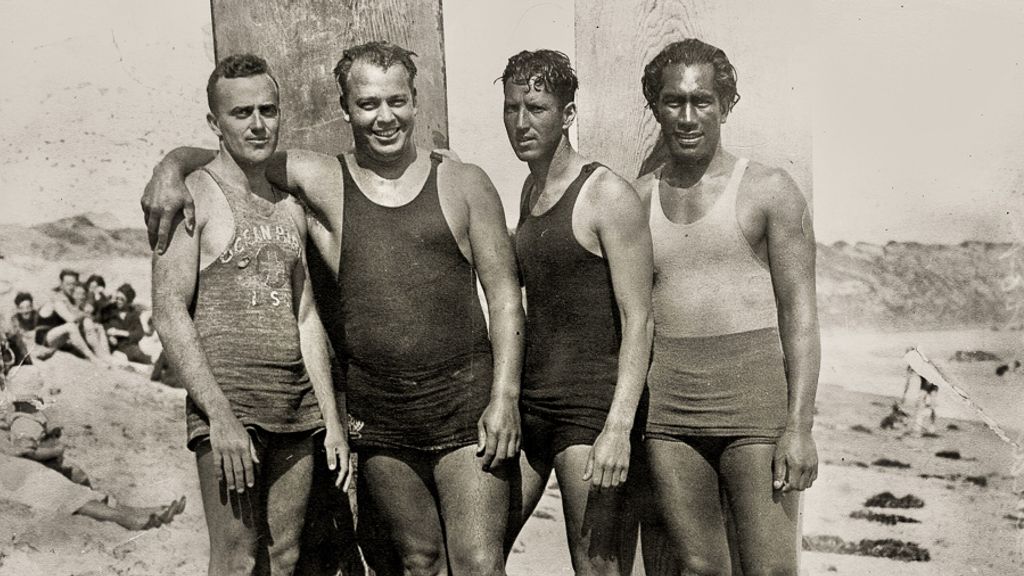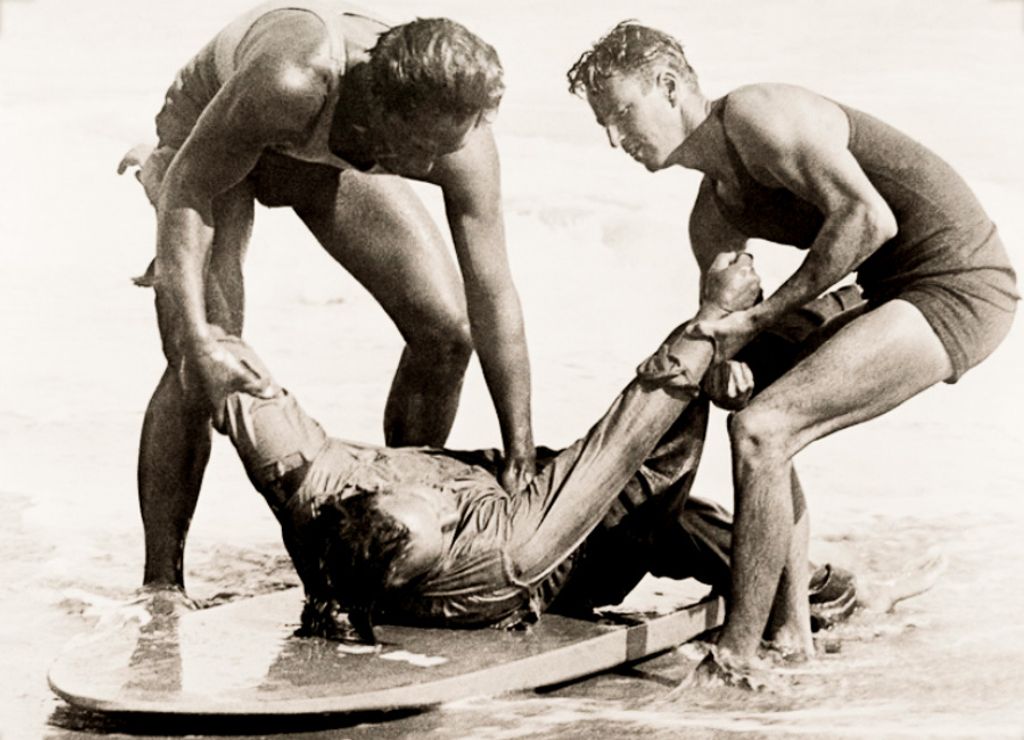"BUT FOR THE WORK OF KAHANAMOKU, WE WOULD ALL HAVE PERISHED," DUKE'S HEROIC 1925 RESCUE AT CORONA DEL MAR

"Riverside Men Perish on Fishing Trip When Boat is Upset by Ground Swell," by A.B. Berry, was a front page Orange County Register story on June 15, 1925. This version has been slightly edited.
* * *
Fire men were drowned and 12 others narrowly escaped a similar fate yesterday morning at 6:45 o’clock, when a heavy ground swell, said to have been more than 20 feet high, capsized the 40-foot fishing boat “Thelma,” 150 feet from the end of the jetty, in the entrance of Newport Harbor.
The dead and the survivors were all residents of Riverside. They comprised a fishing party on the way to sea.
THE DEAD
Ralph L. Farnsworth, 38, machinist.
Jonathan A. Morris, 28, clerk.
William Squires, 56, constable.
Edgar Morris, 18, student.
E. E. McClain, 57, machinist.
THE SURVIVORS
Antone Hubelar, Ray McDermott, Myron Bland, Albert Johnson, F. W. Hock, Edward Sneed, Earl Griggs, George Mott Jr., Harry Ohlin, Westley Berry, Frank Morris. A. Haber.
Old fishermen and beach guards who witnessed the accident wondered if it were not the return of the same 20-foot breaker, which on the second Sunday in June, last year, swamped the fishing boat “Adieu’’ in the same spot, drowning eight Santa Ana men and boys. Yesterday's accident was said to have been almost identical in circumstances to last year’s tragedy.
The accident was witnessed by scores of persons. It was only due to fast rescue work, led by Duke Kahanamoku, Hawaiian swimmer and holder of many world records, that the entire party was not swept to a watery grave.
The boat was owned by "Gavvy" Cravath of Laguna Beach, former baseball star with Philadelphia, and by Myron Bland, Riverside merchant. Bland was in charge of the boat at the time of the accident.
The bodies of Farnsworth, Johnathan Morris and William Squires were brought to shore at the same time with the rescued men, and valiant first aid work was done in an effort to restore life, the bodies being worked on for hours, bat no spark of life was revived.
The bodies of Edgar Morris and McClain were not seen by the rescuers who swam around the boat for hours in an effort to find them. “I have sailed out of Newport Harbor for years," Bland said yesterday, soon after being taken out of the water by Kahanamoku, "and this morning when I turned the boat seaward, I saw nothing to hinder me. There were no ground swells, no large breakers coming in.”
Bland said that, as his boat rounded the end of the jetty, the first ground swell struck the boat, then another. With the second, the glass in the cabin was broken and water splashed on the motor, swamping It.
Realizing the safety of all men aboard depended on the motor being kept going, Bland bravely dashed into the engine room below, and was there when the third mighty breaker struck the boat. He remembers nothing else.
Several of the survivors, who were on deck at the time, substantiated the story told by Bland. There were only three giant waves. The “Thelma” rode through two of them, and the third, larger than the rest, swamped the boat. When struck by the third wave, the boat overturned, and in the under current it turned over again and again. Men were swept from the rail like flies, and thrown into the heavy seas. A few managed to hold to the railing and stayed with the boat, and as a result were badly beaten by the waves.
The boat was swept toward the Palisades, and was finally wrecked on a sandbar directly in front of the Corona Del Mar clubhouse, across the harbor from Balboa. There it remained until early today, when boatmen towed it to the inner harbor.
Edward Sneed, one of the survivors, suffered a broken collarbone and other injuries. He was taken to the Santa Ana Valley hospital, following his rescue. He was removed to a hospital in Riverside, last night.

Duke Kahanamoku, with Owen Hale (229 West 81st Street, Los Angeles), Gerald Vultee (321 South Gramercy Street, Los Angeles), and William Herwig, newspaper artist, of Los Angeles, all witnessed the accident from the shore. All immediately gave aid, and it was through their efforts, and through the efforts of Capt. T W. Sheffield, of the Corona Del Mar clubhouse, at the Balboa Palisades, that the rescued men were brought to shore.
"The Duke" and party were encamped on the beach near the place where the boat was beached. They were just ready for their morning swim. Dashing into the water with their surf boards, the four men brought in 15 of the 17 men aboard, bringing three at a lime, to shore on their surfboards. The rescue work, carried out almost as swiftly as the time It took the ground swell to swamp the boat, was said by Captain Sheffield to have been the best he had ever seen, in 40 years of sea-going.
Duke Kahanamoku, with his mighty swimming strokes, seemed to be all around them at all times, and whenever a head bobbed up, he was there to grab the drowning man and place him on a surfboard. Hale, Vultee, and Herwig were as active, and in several Instances they were dragged under the surface by the death clutches of the drowning men, but in each instance they broke the clutch and saved their man.
Three men to a board was the rule the rescuers kept to, and on two occasions men, fighting madly, fell off the board into the water. It kept the four busy keeping them up above water, and in shoving the boards shoreward to Captain Sheffield and Antar Daraga, government weather forecaster and lifeguard, who hauled the men to the beach.
Charlie Plumber, Balboa man, was on the end of the point at the time the boat was capsized. He immediately jumped into the water and swam across the channel to tho boat. Plumber is credited with saving at least one of the survivors.
"But for the work of Kahahamoku and the others, we would all have perished," said F.W. Hock, one of the survivors. "The Hawaiian was a wizard, and he seemed to have everything in his hands as we were fighting, out there in the water,"
As the men were taken onto the beach, Mrs. Daraga and Mrs. Mary Grigsby, a nurse, worked on the unconcious men. and it was through their efforts that several were brought back to life.
The four hero rescuers “just happened" to be at Corona Del Mar at the time of the accident. They are members of the Los Angela Athletic Club, and are all expert swimmers. All are members of the Corona Del Mar Surf Boat Club, originated by Captaia Sheffield, and were down for the weekend, to perform surfboard stunts.

The checkered flag, meaning "distress," was flying from a flagpole near the entrance of the harbor, at the time of the incident, according to a statement made last night by Daraga, who put the flag there, he said.
Daraga said yesterday that the flag was put out early yesterday morning because the waves were hitting the jetty with greater force then he had ever seen, and that he considered the harbor entrance dangerous at the time.
Bland, who was on the witness stand at the coroner's inquest, held at the Smith and Tuthill Funeral Parlor at 4 o’clock yesterday afternoon, stated that he saw no warning signal and that he was not told in advance that ground swells had been seen in the harbor.
Ho said that he was of the opinion that there were only three of the large ground swells, and that his boat was in the entrance to the harbor at that time.
A coroner's jury, investigating the accident, returned a verdict of ’’unavoidable and accidental,” completely exonerating Bland from any responsibility for the accident. Various members or the jury at times asked that something be done to make the harbor safe for persons who rode out through Its entrance, but in their verdict they made no recommendations.
Rumors to the effect that there were no life preservers on board the "Thema" at the time, and that none of the men were able to swim, wore unfounded, it was learned at the inquest.
More than one of the survivors testified that special precautions had been taken regarding life preservers and that there wore more than double the amount of preservers on board than were needed. "We didn't have time to use the life preservers," said Albert Johnson, a Scotchman, who testified that he had been a sailor for years and had figured In several sea tragedies.
Several men testified that they saw life preservers floating on the water Immediately after the accident, but none was used, they said.
That few of the men were swimmers was told at the inquest. Constable William Squires was an expert swimmer, however, it was said. Although handicapped by having only one hand, he was said to he an expert. His body was among those recovered.
* * *
"SIDELIGHTS ON SUNDAY'S DISASTER"
Waves In the Newport Harbor were higher yesterday morning than they have been seen in months, it was said. They broke over the jetty with greeter force, and seemed to bo more ferocious.
The lighthouse on the Jetty was swept away by the waves. It is the first time that has ever happened, according to Antar Daraga, government weather forecaster, whose duty it is to see that the light is there at all times. Under perilous conditions, Daraga, with Duke Kahnnamoku, Owen Hale and others, risked their lives on the rocks to see that the light was saved. They managed to fix it, temporarily, after being thrown into the sea on two different occasions.
Huge bonfires, built by bathers and members of the personnel of the Corona Del Mar clubhouse, aided greatly in giving comfort to the sea-wrecked survivors.
The coolness displayed by Duke Kahanamoku, Owen Hale, Gerard Vultee, and “Bill" Herwig, the four hero rescuers, was one of the outstanding features of the rescue.
After their work was done, they went to tho clubhouse for breakfast. An excited waiter appeared and began telling of the tragedy. The four men pleaded ignorance of the affair and were told in excited terms all about tho drowings and the heroic rescue work. None of the four said a word, and the waiter went away thrilled that he should be the first to tell the story to persons who apparently knew nothing of the disaster.